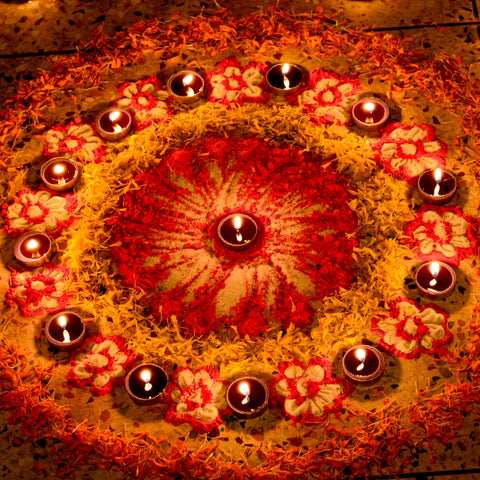The Symbols of Diwali
Deepavali or Diwali celebrates light over darkness, good over evil, and wisdom over ignorance. Many tales are associated with the Festival of Lights, which is celebrated between mid-October and mid-November in myriad ways by people all over India.
But what unites celebrants is the essence of the occasion - the shared signs, symbols and icons that signify illumination in the hearts of believers the world over.
1. Ganesha

Ganesha, arguably the most popular of all Hindu deities, is depicted with an elephant head and a human body.
Symbolically, the elephant head represents knowledge and power and suggests the gentle strength of God. Born of unguents from the skin of his mother, the goddess Shakti, Ganesha received his elephant head as a replacement for his human one, which was severed by his father Shiva due to a misunderstanding. Shiva then made him leader of all beings and decreed that Ganesha be first venerated before any other.
Hindus will first propitiate Ganesha before undertaking any activity as he presides over all beginnings and functions as the remover of obstacles. Images of Ganesha are usually hung over thresholds and he occupies prime position in family altars. During Deepavali, prayers and offerings reach him first for a blessed celebration. Some Indian businesses also mark the beginning of their fiscal calendar during Deepavali and hold special prayers to Ganesha and Lakshmi, the goddess of prosperity, for success in the coming year.
2. Bindi/Pottu

Traditionally, married Hindu women wear a red dot on their forehead between their eyebrows, while unmarried girls wear a black one. This red dot is known as bindi in most of central and northern India, or pottu/bottu in the south. The word bindi originates from the Sanskrit word bindu, meaning “drop” or “small particle”, and refers to the dot worn by women, while for men it is called tilaka.
The bindi is placed at the ajna point - the sixth chakra of the human body - as it represents the spiritual third eye and is said to protect the wearer from the evil eye and negative energies. Guests visiting Hindu homes during Deepavali are welcomed with a dot of red or saffron powder as a sign of auspiciousness.
3. Aum

Perhaps the most recognisable symbol from Hindu culture, the aum is a mystical and sacred symbol, syllable, mantra and bija (root sound) found in almost all faiths from the Indian subcontinent. The syllable is broken into three parts, with each representing one aspect of the divine. A (akaar) represents the vibration that manifests the universe, U (ukaar) stands for the energy that sustains creation, and M (makaar) embodies the dissolution of creation, paving the way for the cycle to repeat.
It also symbolises the Hindu trinity of Brahma, Vishnu and Shiva, and the three stages of life - birth, life and death. The vibration created by the deep and sonorous chanting of aum energises the body and mind, and no Hindu prayer is uttered without this sacred syllable preceding it.
4. Lotus

The pink lotus, specifically the Nelumbo nucifera variety, features prominently in Hindu, Buddhist and Jain iconography. Gods and goddesses sit on lotus thrones and hold the flower in their hands.
Philosophically, the bloom extols the virtue of remaining untarnished by external circumstances - the lotus grows in a bed of mud and yet, the flower floats on the water’s surface, pure and unsullied by the muck underneath.
The lotus, or padma, is also closely associated with Lakshmi, the goddess of prosperity and auspiciousness, who is given a special welcome into homes during Deepavali.
5. Rangoli/Kolam

During Deepavali, floor art makes a bigger appearance at the entrances of homes and temples. In northern and central India, floor art is referred to as rangoli while it is known as kolam in south India.
Rangoli is colourful and made with dyed rice, flour and flowers shaped into free-form designs. The southern versions are drawn using rice flour only and generally follow a precise geometric design with a series of interlinking dots creating the form. The main purpose of the floor art is to feed small animals, birds and insects.
On a religious level, it is said to welcome Lakshmi into the home. However, according to some elders, drawing the rangoli or kolam, which is strictly a female activity, enables the woman drawing it to take respite from her daily chores, thus enabling her to focus on herself and her creative energies.
6. Oil Lamps

Lighting oil lamps for Deepavali is the highlight of the celebration, as “deepavali” and “diwali” mean “rows of light”.
In southern India, mythology says that Krishna vanquished Narakasura and the demon’s final wish was that the people celebrate his death by lighting oil lamps to mark happier times. In the north, Rama’s return to Ayodhya from 14 years of exile after slaying Ravana is celebrated by lighting oil lamps.
